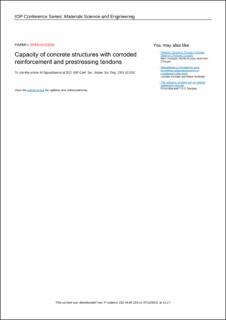| dc.contributor.author | Sigvaldsen, Marie | |
| dc.contributor.author | Ersdal, Gerhard | |
| dc.contributor.author | Markeset, Gro | |
| dc.contributor.author | Samarakoon, Mudiyansele Samindi Manjula K | |
| dc.contributor.author | Langeteig, Magne | |
| dc.date.accessioned | 2022-02-22T11:57:21Z | |
| dc.date.available | 2022-02-22T11:57:21Z | |
| dc.date.created | 2021-12-23T20:55:47Z | |
| dc.date.issued | 2021 | |
| dc.identifier.citation | IOP Conference Series: Materials Science and Engineering. 2021, 1201 . | en_US |
| dc.identifier.issn | 1757-8981 | |
| dc.identifier.issn | 1757-899X | |
| dc.identifier.uri | https://hdl.handle.net/11250/2980764 | |
| dc.description.abstract | The main degradation mechanism for concrete structures is corrosion of the reinforcement and prestressing tendons. Management of structures with such degradation requires detailed understanding of their remaining strength and safety and if necessary, make a decision regarding repairs or replacement of the structure or components. Some simplified methods for estimating the residual capacity of concrete structures do exist, primarily based on a reduction of the flexural capacity equal to the percentage of the corroded area. In this paper, a more physical understanding and description of the influence of corrosion on the strength is investigated, based on a reduction of the area of the reinforcement and prestressing tendons both due to uniform corrosion and pitting corrosion. The results of these models are successfully compared to experimental results of concrete beams with corrosion. Particularly corrosion of post-tensioned tendons is a concern for concrete structures. Some disturbing examples of collapse of concrete bridges have been seen as a result of such corrosion. The paper highlights the importance of the significant strength loss of the reinforcement as a result of corrosion itself, but also the loss of ductility due to possible hydrogen embrittlement and hydrogen induced stress corrosion cracking. The paper also suggests sulphate reducing bacteria as a possible explanation to corrosion issues related to corrosion of post-tensioned tendon structures where no chloride is found. The aim of the paper is to propose a method to calculate a lower bound estimate of the remaining capacity of concrete beams with corrosion damage to reinforcement and to the prestressing tendons. | en_US |
| dc.language.iso | eng | en_US |
| dc.publisher | IOP Publishing | en_US |
| dc.relation.ispartofseries | IOP Conference Series: Materials Science and Engineering;Volume 1201, Third Conference of Computational Methods & Ocean Technology (COTech 2021), Stavanger, Norway and Second Conference of Oil & Gas Technologies in Cold Climate (OGTech 2021) 25th-26th November 2021, Moscow, Russia | |
| dc.rights | Navngivelse 4.0 Internasjonal | * |
| dc.rights.uri | http://creativecommons.org/licenses/by/4.0/deed.no | * |
| dc.subject | Concrete structures | en_US |
| dc.subject | Concrete structure capacities | en_US |
| dc.subject | Corrosion | en_US |
| dc.subject | Concrete degradation | en_US |
| dc.subject | Corrosion causes | en_US |
| dc.title | Capacity of Concrete Structures with Corroded Reinforcement and Prestressing Tendons | en_US |
| dc.type | Peer reviewed | en_US |
| dc.type | Journal article | en_US |
| dc.description.version | publishedVersion | en_US |
| dc.source.articlenumber | 012052 | en_US |
| cristin.ispublished | true | |
| cristin.fulltext | original | |
| cristin.qualitycode | 1 | |
| dc.identifier.doi | https://doi.org/10.1088/1757-899X/1201/1/012052 | |
| dc.identifier.cristin | 1971854 | |
| dc.source.journal | IOP Conference Series: Materials Science and Engineering | en_US |
| dc.source.volume | 1201 | en_US |
| dc.source.pagenumber | 16 | en_US |

